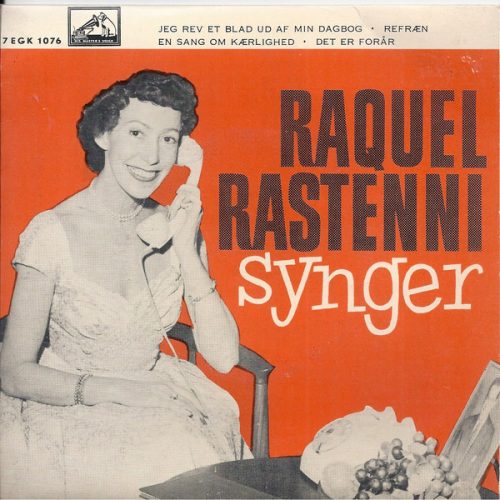We know a lot about Eurovision; this is knowledge we want to share with you. Therefore we’d like to bring you a blast from the past. Back to 1958, when Denmark was represented by Raquel Rastenni with “Jeg rev et blad ud av min dagbog”.
Denmark in the Eurovision Song Contest
Hey, wait… it was only 1958! In Hilversum, The Netherlands, the 3rd Eurovision Song Contest was about to take place. Denmark expressed the wish to participate in 1956 already, but that didn’t happen. In 1957, Birthe Wilke & Gustav Winckler represented the country, ending their performance with the famous long lasting kiss. They ended up 3rd. How on earth could a performance be more spectacular than that one?
Dansk Melodi Grand Prix
The national final was held on February 16th in studio 2 of Radiohuset in Copenhagen. Six songs competed in the contest that was hosted by Sejr Volmer-Sørensen:
- Nanina, sung by Bent Weidlich
- Jeg rev et blad ud av min dagbog, sung by Raquel Rastenni
- For altid, sung by Birthe Wilke and Gustav Winckler
- Evas lille sang, sung by Preben Uglebjerg
- Mit gamle hakkebræt, sung by Preben Neergaard
- Refræn, sung by Raquel Rastenni
After the presentation of the songs, the winner, song no. 2, was announced. No other results are known.
Raquel Rastenni
Raquel Rastenni was born as Anna Rachel Rastén, August 21 1915, in Copenhagen. She began her career as a dancer in the Helsingør Revyen in 1936 and had her debut as a singer in 1938. She also had her radio debut in that year. In 1940, she formed her own swing trio. That same year, her first record was released. She also toured in Sweden at the time.
Being Jewish, Raquel had to flee to Sweden in October 1943 with her family due to the occupation. She spent the rest of the war years here, where she continued her success.
In 1945, Raquel Rastenni returned to Denmark, and in the following years she became Denmark’s leading singer. Among her successes were “Vovsen i vinduet” (1953, Danish version of the English song (How Much Is) That Doggie in the Window?) And Heksedansen (1960). In the 1970s, she expanded the repertoire with Jewish songs. Her best-selling record was “Hele ugen alene” (1953), which sold over 120,000 copies. She was the first Danish artist to achieve a gold record for a million. sold gramophone records. She continued to receive awards throughout her career.
She represented Denmark in the 1958 Eurovision song contest. She participated twice more in the Danish Melodi Grand Prix. In 1961 she sang a duet with Grethe Sønck, “Hjemme hos os“, which ended in a shared 5th place, and as a soloist in 1964 with the song “Vi taler samme sprog”.
During the Yom Kippur War in the Middle East in 1973, she sang a backing track for Israel with Yiddish and Hebrew songs; she often visited the country and in 1975 was inscribed in Jerusalem’s so-called Golden Book.
In the late 1980s, she retired from public life. She passed away in Skodsborg in North Sealand four days before her 83rd birthday.
Jeg rev et blad ud av min dagbog
“I tore a page out of my diary, every little word I regret my dear”, that was what Raquel Rastenni sang. The full lyrics can be found here. Sven UIrik and Harry Jensen co-wrote the song. Kai Mortensen was the conductor in Hilversum. On stage, Raquel Rastenni literally did what she sang: she tore a page out of her diary.

Results
Three countries all had one vote for the Danish song: Sweden, France and The Netherlands. That brought Denmark to an 8th place out of 10, which was much less successfull than the year before.
photo credits: Beeldengeluidwiki



